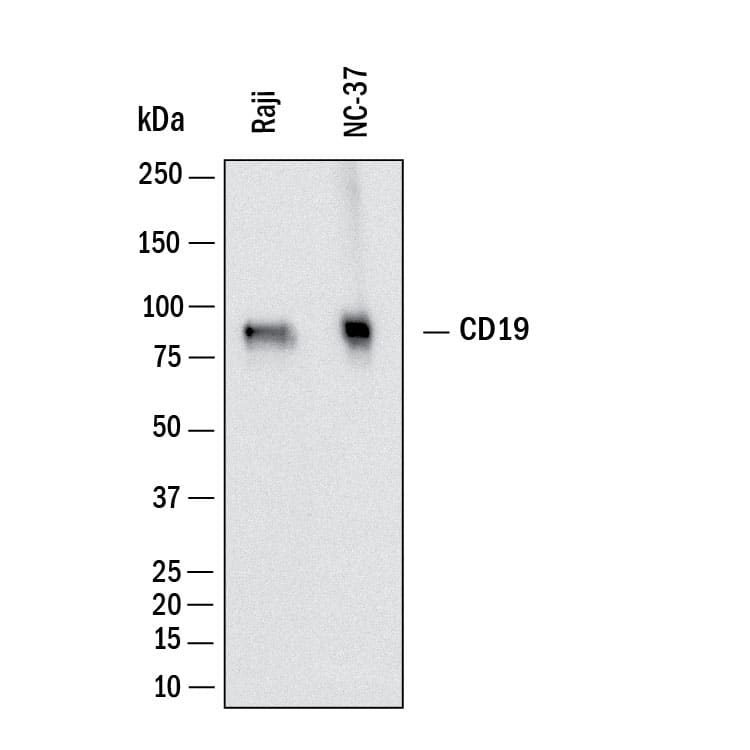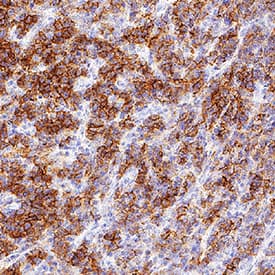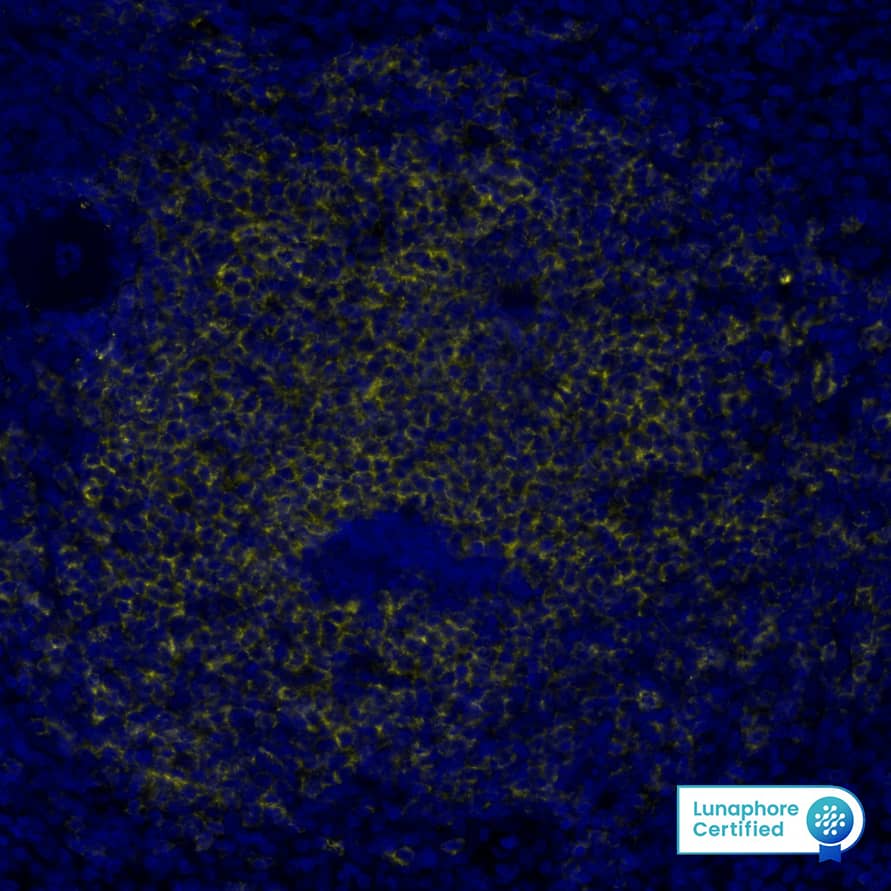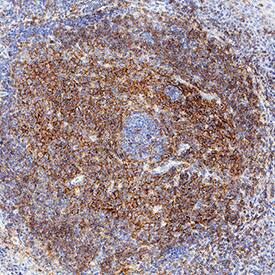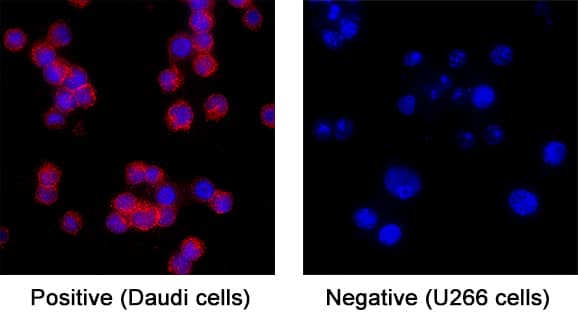Human CD19 Antibody
R&D Systems, part of Bio-Techne | Catalog # MAB11717

Key Product Details
Species Reactivity
Human
Applications
Multiplex Immunofluorescence, Immunohistochemistry, Western Blot, Immunocytochemistry
Label
Unconjugated
Antibody Source
Monoclonal Mouse IgG2B Clone # 1062909
Product Specifications
Immunogen
Chinese Hamster Ovary cell line, CHO-derived human CD19
Met1-Lys291
Accession # P15391
Met1-Lys291
Accession # P15391
Specificity
Detects recombinant human CD19 protein in Direct ELISA.
Clonality
Monoclonal
Host
Mouse
Isotype
IgG2B
Scientific Data Images for Human CD19 Antibody
Detection of CD19 in Human spleen via seqIF™ staining on COMET™
CD19 was detected in immersion fixed paraffin-embedded sections of human spleen using Mouse Anti-Human CD19, Monoclonal Antibody (Catalog #MAB11717) at 5ug/mL at 37 ° Celsius for 4 minutes. Before incubation with the primary antibody, tissue underwent an all-in-one dewaxing and antigen retrieval preprocessing using PreTreatment Module (PT Module) and Dewax and HIER Buffer H (pH 9; Epredia Catalog # TA-999-DHBH).Tissue was stained using the Alexa Fluor™ 647 Goat anti-Mouse IgG Secondary Antibody at 1:200 at 37 ° Celsius for 2 minutes. (Yellow; Lunaphore Catalog # DR647MS) and counterstained with DAPI (blue; Lunaphore Catalog # DR100). Specific staining was localized to the membrane. Protocol available in COMET™ Panel Builder.Detection of Human CD19 by Western Blot.
Western Blot shows lysates of Raji human Burkitt's lymphoma cell line and NC-37 human Burkitt's lymphoma B lymphoblast cell line. PVDF membrane was probed with 2 µg/ml of Mouse Anti-Human CD19 Monoclonal Antibody (Catalog # MAB11717) followed by HRP-conjugated Anti-Mouse IgG Secondary Antibody (Catalog # HAF018). A specific band was detected for CD19 at approximately 95 kDa (as indicated). This experiment was conducted under reducing conditions and using Western Blot Buffer Group 1.Detection of CD19 in Human B-cell Lymphoma.
CD19 was detected in immersion fixed paraffin-embedded sections of human b-cell lymphoma using Mouse Anti-Human CD19 Monoclonal Antibody (Catalog # MAB11717) at 5 µg/ml for 1 hour at room temperature followed by incubation with the Anti-Mouse IgG VisUCyte™ HRP Polymer Antibody (Catalog # VC001) or the HRP-conjugated Anti-Mouse IgG Secondary Antibody (Catalog # HAF007). Before incubation with the primary antibody, tissue was subjected to heat-induced epitope retrieval using VisUCyte Antigen Retrieval Reagent-Basic (Catalog # VCTS021). Tissue was stained using DAB (brown) and counterstained with hematoxylin (blue). Specific staining was localized to the membrane. View our protocol for IHC Staining with VisUCyte HRP Polymer Detection Reagents.Applications for Human CD19 Antibody
Application
Recommended Usage
Immunocytochemistry
3-25 µg/mL
Sample: Immersion fixed Daudi human Burkitt's lymphoma cell line
Sample: Immersion fixed Daudi human Burkitt's lymphoma cell line
Immunohistochemistry
3-25 µg/mL
Sample: Immersion fixed paraffin-embedded sections of human B-cell lymphoma, spleen, and tonsil
Sample: Immersion fixed paraffin-embedded sections of human B-cell lymphoma, spleen, and tonsil
Multiplex Immunofluorescence
5 µg/mL
Sample: Immersion fixed paraffin-embedded sections of human spleen
Sample: Immersion fixed paraffin-embedded sections of human spleen
Western Blot
2 µg/mL
Sample: Raji human Burkitt's lymphoma cell line and NC-37 human Burkitt's lymphoma B lymphoblast cell line
Sample: Raji human Burkitt's lymphoma cell line and NC-37 human Burkitt's lymphoma B lymphoblast cell line
Formulation, Preparation, and Storage
Purification
Protein A or G purified from hybridoma culture supernatant
Reconstitution
Reconstitute lyophilized material at 0.2 mg/ml in sterile PBS. For liquid material, refer to CoA for concentration.
Formulation
Lyophilized from a 0.2 μm filtered solution in PBS with Trehalose.
Shipping
Lyophilized product is shipped at ambient temperature. Liquid small pack size (-SP) is shipped with polar packs. Upon receipt, store immediately at the temperature recommended below.
Stability & Storage
Use a manual defrost freezer and avoid repeated freeze-thaw cycles.
- 12 months from date of receipt, -20 to -70 °C as supplied.
- 1 month, 2 to 8 °C under sterile conditions after reconstitution.
- 6 months, -20 to -70 °C under sterile conditions after reconstitution.
Background: CD19
References
- Wang, K. et al. (2012) Exp. Hematol. Oncol. 1:36.
- Del Nargo, C.J. et al. (2005) Immunol Res. 31:229.
- Yu, F. et al. (2010) J Neurooncol. 103:187.
- Kochenderfer, J. et al. (2015) J. Clin. Oncol. 33:540.
- Lee, D. et al. (2015) Lancet. 385:517.
- Ahmad, A. et al. (2020) Int. J. Mol. Sci. 21:3906.
Alternate Names
CD19, CVID3, Leu-12
Entrez Gene IDs
Gene Symbol
CD19
UniProt
Additional CD19 Products
Product Documents for Human CD19 Antibody
Product Specific Notices for Human CD19 Antibody
For research use only
